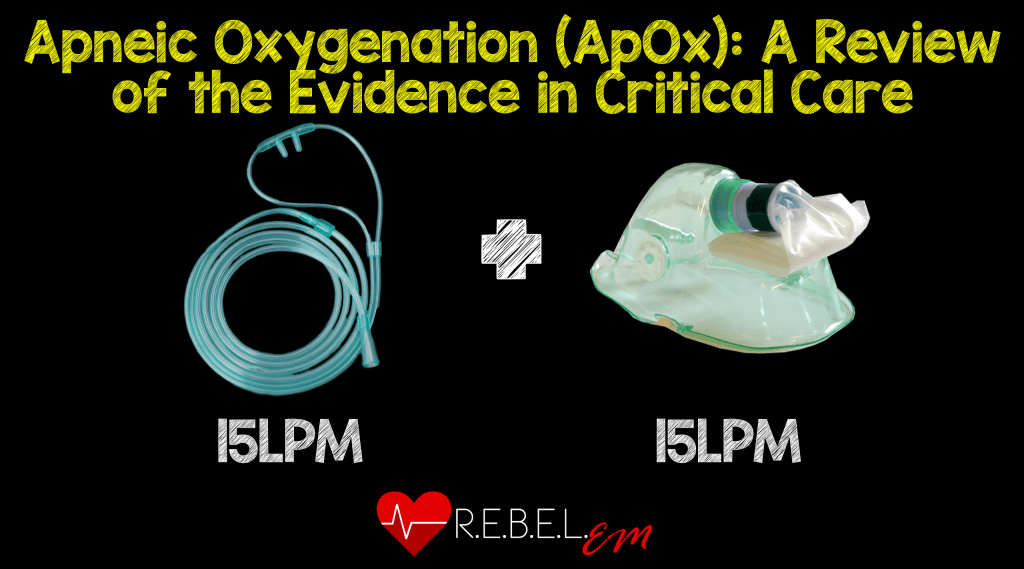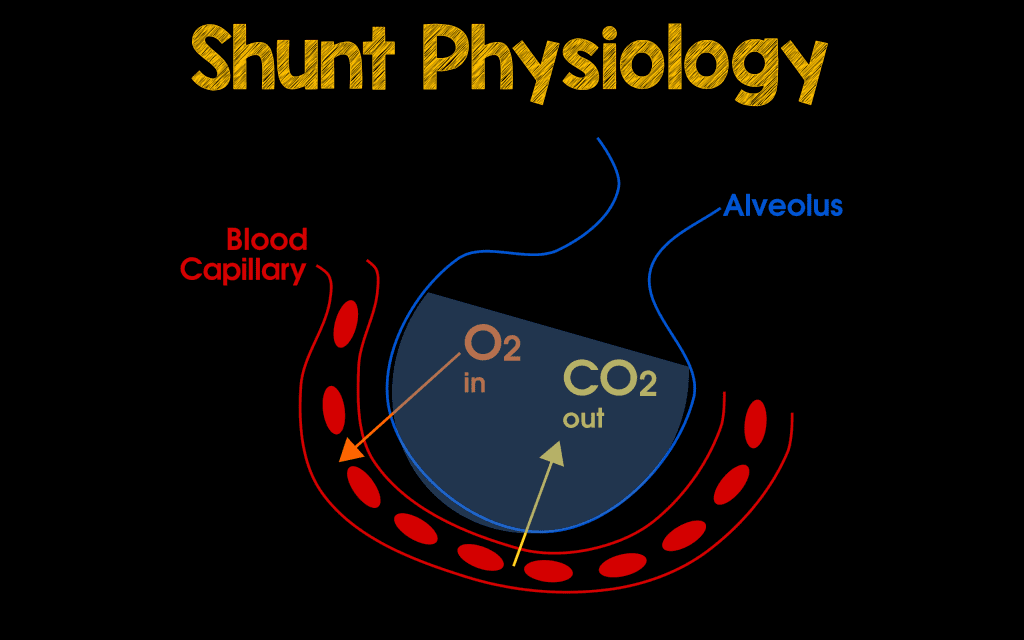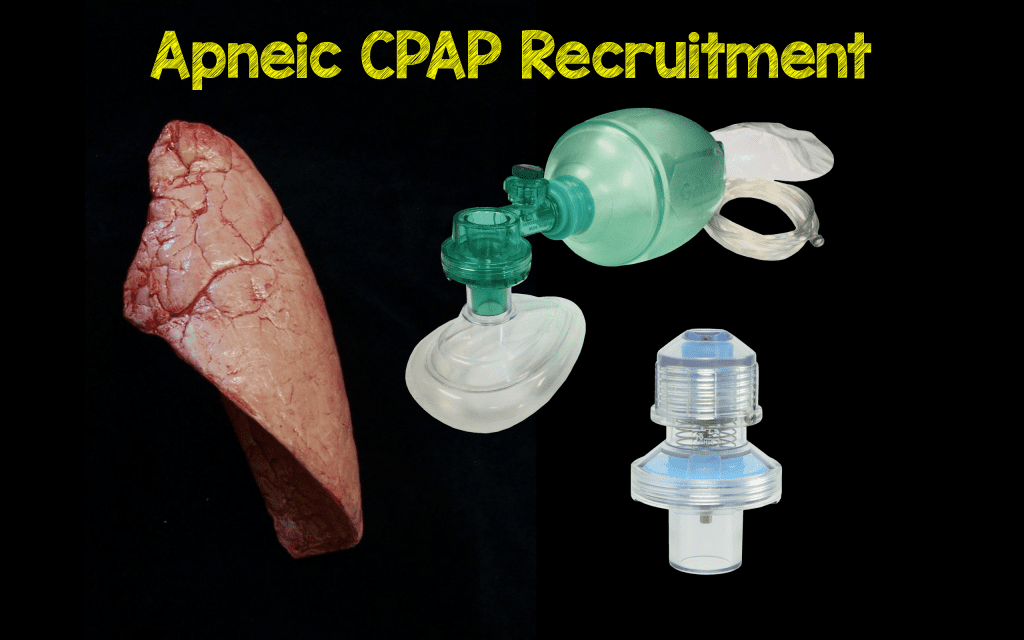 Background: Apneic oxygenation (ApOx) is the passive flow of oxygen into the alveoli during apnea. This passive movement occurs due to the differential rate between alveolar oxygen absorption and carbon dioxide excretion producing a mass flow of gas from the upper respiratory tract into the lungs. Another important component of this maneuver is maintaining a patent airway so that supplemental oxygen administered through the nares is able to be delivered to the alveoli. This practice has been a game changer in emergency airway management for many providers. However, there are still some naysayers that believe in the sickest patients ApOx may not be so beneficial. This post is a review of two recent systematic reviews/meta-analyses published in the critical care and ED/retrieval settings on the use of ApOx.
Background: Apneic oxygenation (ApOx) is the passive flow of oxygen into the alveoli during apnea. This passive movement occurs due to the differential rate between alveolar oxygen absorption and carbon dioxide excretion producing a mass flow of gas from the upper respiratory tract into the lungs. Another important component of this maneuver is maintaining a patent airway so that supplemental oxygen administered through the nares is able to be delivered to the alveoli. This practice has been a game changer in emergency airway management for many providers. However, there are still some naysayers that believe in the sickest patients ApOx may not be so beneficial. This post is a review of two recent systematic reviews/meta-analyses published in the critical care and ED/retrieval settings on the use of ApOx.
Review #1: Pavlov I et al [1]:
What They Did:
- Systematic review and meta-analysis of studies using apneic oxygenation performed in critical care settings
Outcomes:
- Primary: Effect of apneic oxygenation on incidence of clinically significant hypoxemia during emergency endotracheal intubation
- Secondary:
- Incidence of Increasingly Severe Hypoxemia (SpO2 <90%, SpO2 <80%, SpO2<70%)
- Incidence of Death of Any Cause During 28 Days Following endotracheal Intubation
Definition:
- Clinically Significant Hypoxemia: Any fall of SpO2 to a level at which any further drop will lead to a near-exponential drop in SpO2. Conventionally this has been defined as SpO2 <90%
Inclusion:
- Studies of ApOx performed in an adult critical care setting (i.e. emergency department, intensive care unit, prehospital emergency transport)
Exclusion:
- Studies that did not have control groups (Authors included observational studies to increase the power of their review. Observational studies don’t really have control groups .They have exposed and non-exposed groups.)
Results:
- 9 studies (n = 1953) included in analysis
- 4 RCTs
- 5 Observational Trials
- Pooled absolute risk of clinically significant hypoxemia (7 studies included):
- Usual Care: 27.6%
- ApOx: 19.1%
- ApOx reduced the relative risk of hypoxemia by 30%
- ApOx reduced the absolute risk of hypoxemia by 8.5%
- Mortality (3 studies included)
- Usual Care: 44.8%
- ApOx: 34.8%
- Relative Risk of Death 0.77 (95% CI 0.59 – 1.02) – Barely NOT Statistically Significant
Strengths:
- Meta-analysis conformed with the Preferred Reporting Items for Systematic Reviews and Meta-Analyses (PRISMA) and Meta-Analyses of Observational Studies in Epidemiology (MOOSE) guidelines
- No disagreements between reviewers arose on which studies to include in the review
- Risk of bias in randomized controlled trials was assessed with the Cochrane Collaboration Tool and the Risk of Bias Assessment tool for Non-Randomized Studies (RoBANS) for observational studies
- Despite all 4 RCTs using median or mean lowest SpO2 during intubation as the main outcome, the authors of this paper used proportion of patients who experience hypoxemia during intubation
- No heterogeneity between studies making conclusions more reliable
Limitations:
- Strategy of ApOx (Standard Cannula vs High-Flow Nasal Cannula) and reported outcomes of studies differed
- Paucity of studies evaluating the individual secondary outcomes
- Standard care was contaminated with ventilation or some form of ApOx in three of the eight studies, hence diluting the benefit of ApOx
Discussion:
- ApOx reduced the incidence of clinically significant hypoxemia by 30% during emergency intubation in critically ill patients which was consistent in all sub-group analyses studied
- The reduction in mortality with the use of ApOx was not statistically significant and should be interpreted as preliminary and hypothesis generating
- Potential mechanisms of why ApOx would reduce mortality:
- Higher rate of successful intubation on first attempt, reduced risk of adverse events (i.e. critical desaturation, or aspiration due to repeated bag valve mask reoxygenation)
- Hypoxemia demands reoxygenation attempts that may be accompanied by iatrogenic hyperventilation with resulting hypocapnia
Author Conclusion: “Apneic oxygenation significantly reduces the incidence of hypoxemia during emergency endotracheal intubation. These findings support the inclusion of apneic oxygenation in everyday clinical practice.”
Review #2: Binks MJ et al [2]
What They Did:
- Systematic review of six databases for all relevant studies on apneic oxygenation
Outcomes:
- Primary: Desaturation (SpO2 <93 – 95%) and Critical desaturation (SpO2 <80%)
- Secondary: First pass success rate of intubation in the ED and during retrieval
Inclusion:
- Studies evaluating apneic oxygenation during intubation in the ED and during retrieval
Exclusion:
- Studies not using apneic oxygenation in the ED or retrieval setting
Results:
- 6 Trials included (n = 1822)
- Significant reduction in incidence of desaturation (SpO2 <93 – 95%)
- RR = 0.76
- p = 0.002
- Significant reduction in incidence of critical desaturation (SpO2 <80%)
- RR = 0.51
- p = 0.01
- Significant improvement in first pass intubation success rate
- RR = 1.09
- p = 0.004
- Significant reduction in incidence of desaturation (SpO2 <93 – 95%)
Strengths:
- All studies assessed for level of evidence and risk of bias
- First systematic review and meta-analysis to investigate use of apneic oxygenation during intubation in the ED and retrieval settings
Limitations:
- There was only one high quality RCT; All other studies included were low quality evidence (i.e. 3 low quality prospective comparative trials, 1 retrospective comparative trial and 1 retrospective observational trial)
- Significant heterogeneity between studies
- Study protocols differed in their methods of pre-oxygenation (i.e. some used positive pressure ventilation)
- Lack of all-cause 30 day mortality analysis
Discussion:
- In the second study, relative risk reduction was used, however many of us prefer absolute risk reduction. We went ahead and calculated this:
- Desaturation: ARR 5.9% with a NNT = 16.8 to avoid one desaturation event
- Critical Desaturation: ARR 11.9% with a NNT = 8.9 to avoid one critical desaturation event
- First Pass Intubation: ARR 6.2% with a NNT = 16.1 to avoid not getting first pass intubation
Author Conclusion: “Apneic oxygenation may reduce patient hypoxemia during intubation performed in the ED and during retrieval. It also improves intubation first-pass success rate in this setting.”
CAVEAT:
In patients with SHUNT PHYSIOLOGY (PNA, Pulmonary Edema), oxygenation will not help as much as PEEP, as this will help recruit atelectatic alveoli to over come the shunt.

There are several interventions that are possible to overcome this shunt physiology:
- Intervention 1 (My Go To Intervention): ApOx + BVM + Peep Valve
- If O2 Sat NOT >=95% change to BVM set at 15L + PEEP Valve set up to 10 – 15cmH20
- For all causes of hypoxia NC 15LPM + BVM at 15LPM + PEEP Valve 15cmH20 = Best PreOx, ApOx, & ReOx Currently Available
- Important Note: Don’t ventilate with this setup (Apneic CPAP Recruitment of atelectatic alveoli)

- Intervention 2: Delayed Sequence Intubation
- Weingart SD et al. Delayed Sequence Intubation: A Prospective Observational Study. Ann Emerg Med 2015; 65(4): 349 – 55. PMID: 25447559
- Procedural Sedation with the procedure being preoxygenation
- 1mg/kg IV ketamine –>PreOx –> Paralyze –> ApOx –> Intubate
Clinical Take Home Point: Use of Apneic Oxygenation (ApOx) in adult patients requiring emergency intubation, without shunt physiology, in critical care settings, the ED, and retrieval settings is a low cost, low complexity maneuver, and reduces the incidence of hypoxemia and increases first pass intubation rates based on limited studies. Further prospective, randomized trials would be ideal but, in the absence of better evidence, this intervention should be part of everyday clinical practice during emergency intubation, unless future high quality randomized controlled trials prove otherwise.
References:
- Pavlov I et al. Apneic Oxygenation Reduces the Incidence of Hypoxemia During Emergency Intubation: A systematic Review and Meta-Analysis. Am J Emerg Med 2017; [Epub Ahead of Print] PMID: 28647137
- Binks MJ et al. Apneic Oxygenation During Intubation in the Emergency Department and During Retrieval: A Systematic Review and Meta-Analysis. Am J Emerg Med 2017; S0735 – 6757 (17): 30497. PMID: 28684195
- Oliveira L et al. Effectiveness of Apneic Oxygenation During Intubation: A systematic Review and Meta-Analysis. Ann Emerg Med 2017 [epub ahead of print]
For More on This Topic Checkout:
- The Mayo Clinic Blog: Apneic Oxygenation Actually Works (For Some Things)
Post Peer Reviewed By: Anand Swaminathan (Twitter: @EMSwami)



